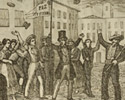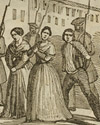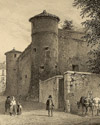19th Century´s militar history in the Basque Country
JOSE ANTONIO MUAGORRI. (1794-1841)
Juan Antonio Muñagorri was born in Berastegi in 1794. He studied to be a clerk in the family tradition, like his father and grandfather, but became involved in diverse businesses, mainly concerning the operation of a number of ironworks in the Valley of Leizaran. In 1832, he was a contractor of works on the road from Vitoria to Irurzun.
The Carlist war paralysed Muñagorri's business, so he contacted a group of notables exiled in Bayonne who were concerned about the duration of the conflict and its consequences for the Basque Country and Navarre.
 These notables saw a need to separate the dynastic conflict from the struggle for the Fueros (regional charters) as a prerequisite for peace. Muñagorri was the visible leader of the "Peace and Fueros" project, which used a proclamation in Spanish and a set of verses in Basque to try and put across the idea that the Basques did not care whether the throne was occupied by Isabel or Don Carlos, so long as its system of Fueros was upheld.
These notables saw a need to separate the dynastic conflict from the struggle for the Fueros (regional charters) as a prerequisite for peace. Muñagorri was the visible leader of the "Peace and Fueros" project, which used a proclamation in Spanish and a set of verses in Basque to try and put across the idea that the Basques did not care whether the throne was occupied by Isabel or Don Carlos, so long as its system of Fueros was upheld.
 The initiative was secretly supported by the Liberal government in Madrid, which provided funds to promote Muñagorri's uprising, in order to weaken the Carlist army. Muñagorri revolted in Berastegi in April 1838, delivering his famous proclamation and attempting to form a new army for Carlist deserters to join. He was rather unsuccessful and had to cross the border with barely one thousand men.
The initiative was secretly supported by the Liberal government in Madrid, which provided funds to promote Muñagorri's uprising, in order to weaken the Carlist army. Muñagorri revolted in Berastegi in April 1838, delivering his famous proclamation and attempting to form a new army for Carlist deserters to join. He was rather unsuccessful and had to cross the border with barely one thousand men.
The Liberal government set up a Board of Notables in Bayonne to support Muñagorri's uprising. The Count of Villafuertes took part on behalf of Gipuzkoa, Iñigo Ortés de Velasco for Alava, Pascual Uhagón for Bizkaia and José María Vidarte for Navarre.
Muñagorri's troops were limited to being stationed in the region of Lastaola, next to the Bidasoa so that they could cross the river and take refuge in Sara in the event of danger. Their sole military action was to take Urdax from the Carlists. The project to create an army of Carlist deserters - which could have been decisive to the events of the First Carlist War - failed, but the idea of separating the dynastic conflict from the struggle for the Fueros was used as the basis of the Bergara Convention. It can be said that Muñagorri paved the way for the Moderate Carlists to reach an agreement with Espartero and put an end to the war.
 After the war, when Espartero came to power in Madrid, there was an uprising of moderate Basque Liberals, in which Muñagorri participated. The failure of the uprising forced Muñagorri to flee to Bayonne and encouraged Espartero to abolish the Fueros in retaliation. Muñagorri returned to his business and was in his Sumarrieta ironworks in Erasun when he was taken prisoner by a lieutenant of Txapelgorris, a faithful follower of Espartero. He was executed in October 1841.
After the war, when Espartero came to power in Madrid, there was an uprising of moderate Basque Liberals, in which Muñagorri participated. The failure of the uprising forced Muñagorri to flee to Bayonne and encouraged Espartero to abolish the Fueros in retaliation. Muñagorri returned to his business and was in his Sumarrieta ironworks in Erasun when he was taken prisoner by a lieutenant of Txapelgorris, a faithful follower of Espartero. He was executed in October 1841.

